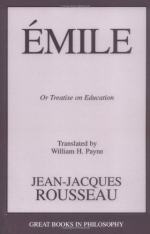Never tell the child what he cannot understand: no descriptions, no eloquence, no figures of speech, no poetry. The time has not come for feeling or taste. Continue to be clear and cold; the time will come only too soon when you must adopt another tone.
Brought up in the spirit of our maxims, accustomed to make his own tools and not to appeal to others until he has tried and failed, he will examine everything he sees carefully and in silence. He thinks rather than questions. Be content, therefore, to show him things at a fit season; then, when you see that his curiosity is thoroughly aroused, put some brief question which will set him trying to discover the answer.
On the present occasion when you and he have carefully observed the rising sun, when you have called his attention to the mountains and other objects visible from the same spot, after he has chattered freely about them, keep quiet for a few minutes as if lost in thought and then say, “I think the sun set over there last night; it rose here this morning. How can that be?” Say no more; if he asks questions, do not answer them; talk of something else. Let him alone, and be sure he will think about it.
To train a child to be really attentive so that he may be really impressed by any truth of experience, he must spend anxious days before he discovers that truth. If he does not learn enough in this way, there is another way of drawing his attention to the matter. Turn the question about. If he does not know how the sun gets from the place where it sets to where it rises, he knows at least how it travels from sunrise to sunset, his eyes teach him that. Use the second question to throw light on the first; either your pupil is a regular dunce or the analogy is too clear to be missed. This is his first lesson in cosmography.
As we always advance slowly from one sensible idea to another, and as we give time enough to each for him to become really familiar with it before we go on to another, and lastly as we never force our scholar’s attention, we are still a long way from a knowledge of the course of the sun or the shape of the earth; but as all the apparent movements of the celestial bodies depend on the same principle, and the first observation leads on to all the rest, less effort is needed, though more time, to proceed from the diurnal revolution to the calculation of eclipses, than to get a thorough understanding of day and night.




